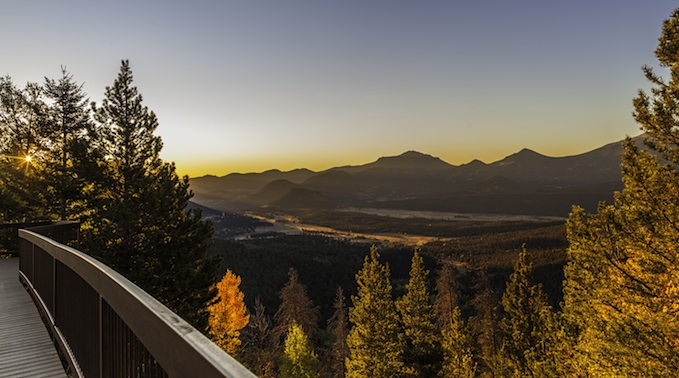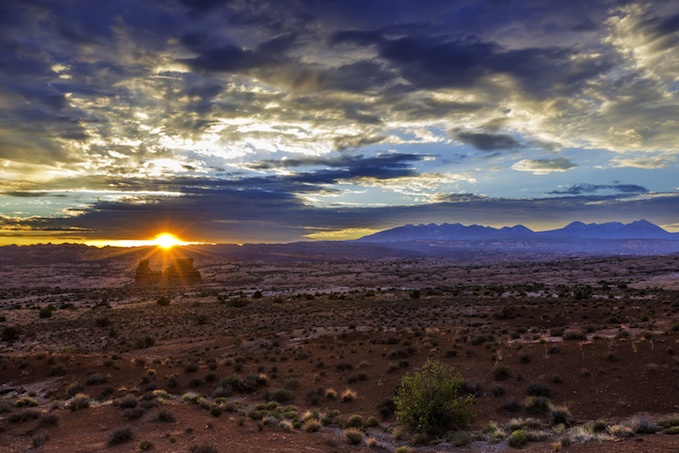Every photographer has his or her favorite season at his or her favorite national park. For wildlife photographers, it may be spring in Yellowstone National Park, when new life abounds and sweet furry little faces fill the frame of a camera’s viewfinder.
Other photographers like the sparkling winter beauty of an ice-encrusted waterfall in Yosemite National Park, or the contrast of white snow against red rock in Arches National Park. Some photographers most enjoy shooting in the summer, when hiking trails are clear of snow, alpine lakes are a deep turquoise hue from glacial melt, and late-blooming flowers carpet the fields of places like Glacier National Park.

Many Parks Curve in Rocky Mountain National Park is a great place to catch the fall sunrise...but you have to be an early riser! Rebecca Latson photo.
Then, there are those photographers—like myself—whose favorite time of year is the fall, when the trees of Rocky Mountain and Acadia national parks are graced with autumnal hues of orange and gold.
Autumn can produce variations in weather ranging from a crystal-clear blue sky over the red huckleberry bushes of Mount Rainier National Park to a storm-cloudy morning in Grand Canyon National Park with intermittent, sunlight-peppered snow showers. Fall air is fresh and sweet, perhaps tinged with the scent from a cabin’s wood-burning stove. The weather is chilly without being bone-freezing cold—a far cry from the humid 80-degree October temperatures of southeast Texas where I currently reside.
Because autumn is my favorite season for photography, I plan most of my national park trips around the months of September, October, and November. I know, though, that the fall season will not bring a drapery of orange, red, and gold to every national park. Some parks have very little foliage to begin with, much less any that change colors with the season. Other parks have plenty of vegetation but are located in regions where frequent precipitation and temperate climates retain a color scheme of varying shades of green.
Nonetheless, the fall season is still my favorite time for photography because of the clarity of light and atmosphere as well as the saturation of colors.
A Must-Have Accessory For The Season
When I travel during the autumn months, one of the camera accessories I always take with me is a circular polarizing filter (aka “polarizer”). Acting on the same principal as the lenses in a pair of sunglasses, polarizers cut through bright glare and reflections on watery surfaces, glass and vegetation, deepen a blue sky, enhance the colors of the landscape, and bring out the drama and detail of clouds.
Some polarizers, such as Singh-Ray’s LB Color ComboTM filter, combine a warming polarizing filter with a color enhancer filter to provide a slightly more golden color saturation within a composition. Singh-Ray’s Gold-N-BlueTM polarizing filter adds a little extra blue or gold hue to the scene with a twist of the filter’s rotation ring.
Always keep in mind that you get what you pay for. If you are spending the money to buy a good lens, then don’t skimp on an accessory like a polarizer; get the best that you can afford.
Timing Is Everything
Regarding timing—and this goes for every season, not just autumn—remember to set your camera’s clock to the time zone of the park you visit. This information is saved to your camera’s metadata and can prove quite helpful when you are trying to remember the date and/or time of image capture for a particular photo.
Another item concerning timing: sunrises and sunsets (the “golden hours”). During the fall, they are especially dramatic. It’s all about that light, clarity, and atmosphere thing based upon the position of the Earth in relation to the Sun during this particular time of year. As a morning person, I don’t worry much about timing because I generally get up at dark-thirty and travel to my location for a sunrise session.
For sunsets, though, I like to have a fairly decent idea of when that time occurs in order for me to stake out my spot at least an hour prior to the actual event. With that in mind, I have found a helpful online site that allows me to choose a national park, month, and year, then generates a calendar of sunrise and sunset times in addition to day length, moonrise, moonset, and latitude & longitude (among other choices).
This site aids me in determining optimal arrival times for setting up my tripod and camera in readiness for those golden hour images. And, when I do capture that fall sunrise or sunset, I set my aperture between f5.6 and f16 to turn that golden orb into a golden starburst.

Fall sunrise on the high desert of Arches National Park. Rebecca Latson photo.
The Little Things
While photographing those broad fall landscapes, don’t forget about the little things around you. This time of year provides extra photo ops to be found literally at a photographer’s feet: a golden aspen leaf on a gray rock, a starfish in a quiet tidal pool while the autumnal sea crashes onto the rocks, or a pocket-sized chipmunk scampering to and fro as it seeks to store food for the winter.
Dress For The Weather
It goes without saying that you should dress both yourself and your camera gear for the fall season’s weather. This means you need layered clothing to shed or put on as the temperature dictates. Autumn weather is changeable, ranging from the 70s to the 40s (Fahrenheit) in the space of an hour or less, with rain showers and snow storms between the sunshine.
In addition to clothing for your body, remember to be proactive regarding “clothing” for your camera gear. Make sure you’ve packed a weather-protective covering like Vortex Media’s Storm Jacket or Op/Tech’s Rainsleeve for your camera and lens to allow you continued shooting out in the elements while others around you pack up their gear and head for shelter.
As the harbinger of winter, the autumn season brings a sense of peace and introspection with its quiet isolation, broken only by the occasional haunting call of a bull elk. Crowds are fewer and dispersed. Colors are saturated. The air is clear and crisp. It’s these elements combined together that make fall my favorite season for photography.



Comments
Another fine story and great pictures from Ms. Latson. Many thanks for sharing.
And thank you, Lee, for the kind words!
Nice article Rebecca :D
Thanks, Rebecca -
As always, some practical tips in a well-written piece, accompanied by beautiful photos!
Thanks, everybody, for such kind word!
Beautiful photos and great tips! Fall is our favorite season as well.